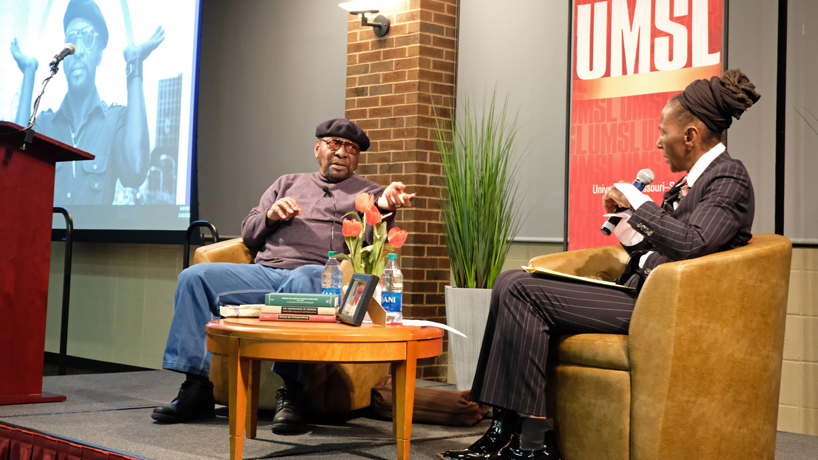
Percy Green (left) and Gwen Moore discuss Green’s role in the local civil rights movement during the annual ‘Black in St. Louis’ event, part of UMSL’s Black History Month programming. (Photo by Burk Krohe)
Strains of “Lift Every Voice and Sing,” often referred to as the black national anthem, swelled Wednesday evening in the J.C. Penney Conference Center Summit Ballroom at the University of Missouri–St. Louis as images of the local civil rights movement flashed on screens before an eager audience.
The impromptu performance kicked off the annual ‘Black in St. Louis’ event hosted by the African American Chapter of the UMSL Alumni Association in conjunction with the Associated Black Collegians. The audience included members of the UMSL community – including both groups – and the St. Louis community.
This year’s event, part of UMSL’s Black History Month programming, featured a lively discussion with Percy Green II, the iconic local civil rights activist. Gwen Moore, an UMSL alumna now serving as the curator of urban landscape and community identity at the Missouri History Museum, talked with Green about activism and his unique, attention-grabbing protests in the 1960s and 1970s.
As a young man, Green was a member of the St. Louis branch of the Congress of Racial Equality before leaving the organization to co-found the Action Committee to Improve Opportunities for Negroes. He often attracted headlines with bold protests. One of his most famous acts of civil disobedience was scaling the Gateway Arch during construction to protest the hiring practices of the project.
Much of the hour-long discussion was dedicated to Green’s philosophy of sustained, direct action protests and the planning and organizing that went into them.
“We defined ourselves as being a proactive organization rather than reactive,” Green said of ACTION. “That meant that we set out looking for a fight, and of course, we were fighting racism so we didn’t have to look that far.”
Green, clad in his signature black beret, recounted the initial split from CORE and the development of ACTION’s goals. It had come after a prolonged picket of Jefferson Bank and Trust, which aimed to get four black tellers hired. Eventually, the group succeeded, but 19 people had been arrested over the course of six months. The arrests caused a rift in the group.
“I was among the 25 progressives in CORE at the time who was not willing to give up direct action protest,” Green said.
ACTION began in 1964, and it emphasized a direct, confrontational approach to civil rights. However, Green wanted to make sure the group’s actions were accomplishing something to better the black community in St. Louis.
“We decided that if we were going to make a make a meaningful impact in the community, then we thought that we should utilize a battle cry for more and better paying jobs for black men,” he said.
Equal access to employment became the primary focus of the group’s efforts. Green felt that economic opportunity would bring stability to black families, allowing them to prosper. In particular, ACTION targeted utility and construction companies in the area such as Laclede Gas (now Spire), Union Electric (now Ameren) and Southwest Bell (now AT&T).
“You didn’t have to have a PhD to learn how to install a telephone or read a meter,” Green said. “Yet, those jobs paid decent salaries.”
Moore steered the conversation toward some of ACTION’s more unique protests, noting that there seemed to be a lot of strategy and planning involved. At that point, Green gave audience members a behind-the-scenes look at the 1964 Gateway Arch protest.
Everything started with a trial run. Green and Richard Daly, a white member of ACTION, put on work coveralls and went to the Arch construction site one day around noon. After walking onto the grounds without incident and touching the Arch, they knew climbing it was possible.
The next step was to set up a slight of hand with the press, alerting local outlets that the group would be protesting at the Old Courthouse due to the exclusion of blacks from federal contracts and jobs related to the construction of the Arch.
“We developed the diversion of the picket line, called the press to let them know that the picket line was going to be in place and that there were going to be some arrests,” Green said. “That was very appealing to the white press.”
Aside from the distraction, the Old Courthouse was also a strategic location because there were public binoculars looking onto the construction. ACTION members would be able to use them to confirm Green and Daly had been successful and then alert the media.
Aside from a few tense moments on the way to the Arch, the protest unfolded according to plan. Green and Daly climbed to a height of about 125 feet, and press members and the police eventually congregated at the scene. When police came up on the worksite’s elevator to talk the two down, Green demanded 1,000 jobs for black workers. The ordeal persisted for about five hours, and Green joked that he only came down because he had to go to work.
The protest gained national attention and was an example of the drastic steps necessary for change. As the conversation wound down, Green reminded the audience that prejudice is deeply ingrained and institutionalized. Without challenges to the status quo, many people – especially those in positions of power – are content to avoid reform.
“We have to make racism a liability rather than an asset,” he said. “If you make it too costly for them to practice racism, then you find businesses will do the right thing.”
Moore asked Green what he thought of his legacy as the talk concluded, and he answered in characteristically bold fashion.
“Oh, I don’t know,” Green said. “I’m not through yet.”














